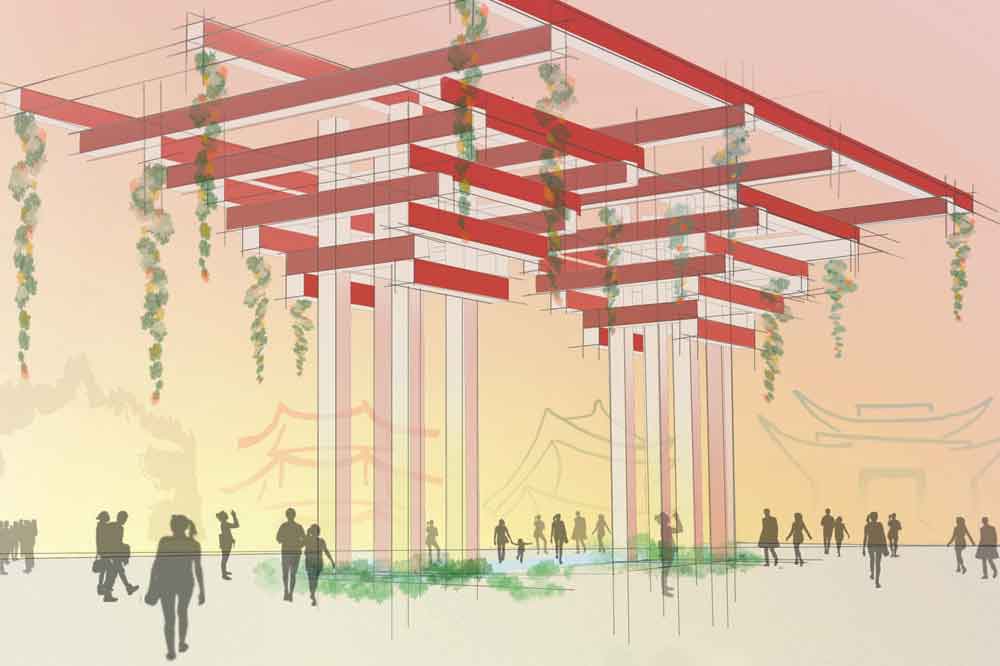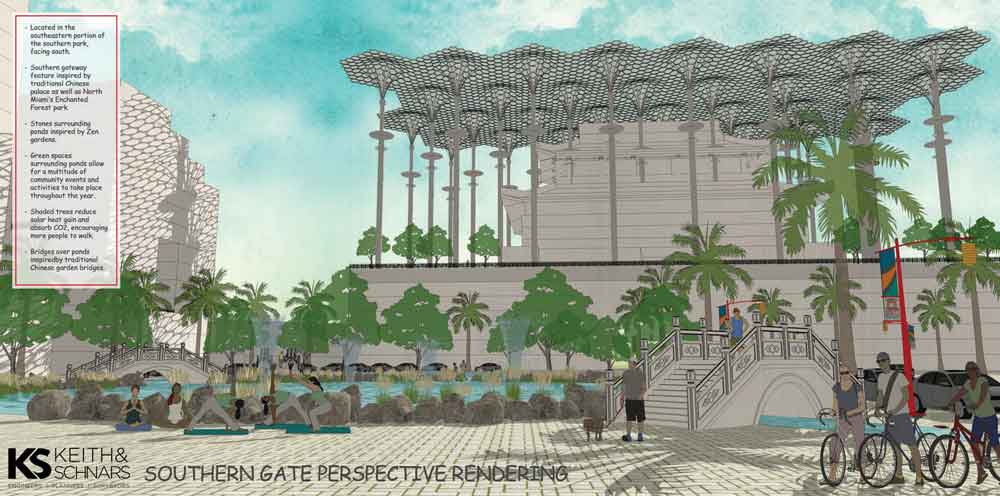
By Larry Spring, Jr.
I wasn’t a stranger to big projects, but the idea that awaited me as I started work as city manager of North Miami, Florida, was unlike anything else I’d been involved in. Building a Chinatown? In North Miami?
I had worked on the development of the new Miami Marlins stadium (retractable roof and all) in my previous post, so I had a good sense for the complexity of projects in urban areas. But that was the city of Miami.
I’d just become manager of North Miami, a suburban community of some 60,000 in the much larger Miami metro area of more than 5 million. Councilman Alix Desulme, who had been approached by local business leaders, had done some initial research. He was passionate and persistent; I listened.
He had an idea to revitalize a 90-acre corridor in his district. My predecessor and now deputy manager Arthur Sorey, had made a significant time investment, flying to China, to get the basics of what is now a Chinatown community redevelopment project.
And slowly, what seemed like a crazy concept, started to materialize as an exciting and viable project. It morphed from an intriguing possibility all the way to a detailed, realistic urban city revitalization plan, complete with zoning, infrastructure, tax incentive, community engagement, and international components.
North Miami is the first community in Florida to designate a Chinatown district and the first with a master plan. Our signature gateway arch, which will celebrate the innovation of New China, will see a groundbreaking later this year.
“I must credit the administration,” Desulme would later say. “All of us were surprised how fast everything kind of evolved and unrolled.”

A Non-Organic Concept
Before I came to my current job, I knew there had been discussions of creating a cultural district in greater Miami as many other cities have done—be it a Little Italy, a Fisherman’s Pier, or other.
The idea of a Chinatown in South Florida was not new but for various reasons, it just never got off the ground. This, despite the fact that China is Miami’s third-largest trading partner with $6.7 billion of import and export transactions in 2016 alone.
And while the Miami metro area is today culturally vibrant with large Hispanic and Caribbean populations, migration from China was blocked by anti-Chinese federal immigration laws until the 1940s, a period overlapping Miami’s heady post-World War II surge.
The patterns set in those decades ripple into today. The most recent U.S. Census data shows that North Miami’s Asian population is just 1.7 percent, and the Chinese demographic is just 0.6 percent. (By way of comparison, San Francisco, San Jose, Los Angeles, and New York have Chinese-American populations ranging from three to 10 percent of their communities). Indeed, while North Miami’s population is majority foreign-born, nearly 48 percent is of Haitian ancestry.
So, although there was a pent-up desire to create a Chinatown, its creation would not be organic, as the Chinatowns of New York and San Francisco were. It would have to be planned to maximize elements mutually interesting to investors and the community, leveraging our advantages.
As an international visitor destination, with world-class and growing seaport, we knew greater Miami had a lot to work with, but there would also be many obstacles.
For communities considering this kind of undertaking, here are some of the lessons we learned in moving this project forward.
Find a Credible Partner
While North Miami may have lacked any sizable Chinese or Asian population, it did have one fantastic resource that we soon discovered would be key to advancing the project: Florida International University (FIU), which maintains one of its campuses along Biscayne Bay.
FIU operates the Chaplin School of Hospitality and Tourism Management and has had the well-regarded Marriott Tianjin China Program in operation since 2006, not far from China’s capital, Beijing.
When our team made the initial trip to China, we benefitted from a carefully planned series of meetings with potential investors. The FIU connection gave our effort credibility, not only with the people we met, but with our own residents who feared their elected leaders were on some kind of irresponsible junket.
I can’t overemphasize how this academic partnership mattered at the beginning and how it continues to nurture each step in the development. “The Miami brand name is very strong in China,” says Dr. Michael Cheng, the interim dean of FIU’s hospitality school.
“I see a lot more Chinese students who will transfer to Miami to complete their graduate work. They just needed a place, to have a reason, to come here,” he says.
Although the FIU program had been operating for a decade before our Chinatown initiative began in earnest, we didn’t understand its full import until later. “We knew, but we really didn’t harness the potential that was laying there, dormant,” said city Planning, Zoning, and Development Director Tanya Wilson-Sejour. “We never translated it into economic development.”
On the first trip, we had brochures in Mandarin, complete with our city logo. We had introductions. The university president was a participant. “They were looking in awe,” said Sorey, describing the welcome our delegation received from packed rooms on the first visit to China.

The Need to Inform
Parallel to the credibility issue for this project was the need to inform the community about the vision, to anticipate questions, and most of all, to persuade. The goal was to avoid the fear that the project would simply be a giant gentrification project aimed at displacing residents and business owners.
This is true of any project, particularly one that will require continued commitment. Here, the designation of the mile-long, 16-block area as the “Chinatown Cultural Arts and Innovation District” project drew some political opposition and even some initial ridicule.
While not unexpected, we needed to quickly communicate the vision and establish trust and buy-in so we conducted a variety of online and paper surveys, built an interactive website, and held four public workshops, including a “Charrette-style” workshop, an intense planning meeting involving all stakeholders focused on design solutions.
This multilayered approach to public engagement intentionally included honoring existing cultural diversity, identifying viable business opportunities for existing commercial operations, and integrating the project into neighboring communities. This included intentional outreach to include residents and property owners in areas adjacent to the proposed district.
Guiding Principles
The result was a set of these guiding principles that would attract broad support from stakeholders:
- First tier: Reinvention, quality of life, innovation, vibrancy, and vibe.
- Second tier: Inspirational design, aesthetics, ecologic commitment, and more.
- Vision: Replacing blight with a livable urban community.
The master plan, developed by engineering firm Keith and Schnars, blew my socks off. It is changing a blighted area centered around a six-lane roadway strip with a modest median into a culturally themed, mixed-use residential and business district.
It will be walkable, filled with usable green spaces, and water features, plus have easy access to a multimodal, regional transportation system, as it is directly off Interstate 95. In short, it’s a game changer.
Here are some of the highlights of the plan put into place after the designation of the district—the city’s legislative action—was made in February 2016.
- Council revised zoning to allow larger residential buildings. We are increasing the maximum building height for one part of the district to 20 stories.
- Government will take a larger role in stormwater mitigation. This will allow investors to build higher and closer to property boundaries with appropriate easements. We believe this will make it easier to achieve sustainability goals. Overall, capital investment will top $52 million.
- Tax incentives include both a rebate system through Miami’s community redevelopment agency and a pre-existing free trade zone. Even more, about half of the district also lies within a new Opportunity Zone. This gives new investors the chance to save hundreds of millions of dollars in capital gains tax.
Along with incentives, we intend to use parking variances to promote affordable housing along with adaptation to the forecast growth of autonomous vehicles.
We have inventoried every single lot in the district, folio by folio, owner by owner, with contact and relevant zoning and value information, making it that much easier for potential investors thinking of developing some 4.8 million square feet of gross leasable space. We’ve already provided tours for three investment groups.
Even better, we are convinced that our Chinatown will be the red carpet to North Miami and a new introduction to the entire city and its attractions, including waterfront property.
Not a Typical Chinatown
Another critical idea in taking an out-of-the box concept to completion is to be willing and able to “shift the paradigm,” as Wilson-Sejour says. We are not trying to duplicate non-organic Chinatowns in Washington, D.C. or Atlanta.
Instead, we recognized that today’s China has already achieved technology parity with the U.S. and that investors want any new development to not only reflect that reality but to promote it. We also learned from urban planners in China that sustainability was critical.
They have seen the urban problems that too-rapid growth has created and want new development to be a model of green planning. As a result, there is more green space, more activated alleyways, more water infrastructure “that also becomes an art form,” Wilson-Sejour says.
Next Steps
Although this project targets a specific area, we’re also aware that real partnerships can broaden the appeal and support for a bold project like our Chinatown. We are, for example, helping the effort to establish nonstop air service to China, from which many businesses and intuitions will benefit.
We are also working to build federal and state relationships for the project, particularly for such regional issues as transportation.
In closing, the success of any project like this one is building sustained political will. As local government managers leading teams of professionals, it falls to us to directly engage each new group of elected officials.
For a project like this one, it means being responsive, flexible, and willing to incorporate new ideas and visions of the project as it evolves, while being ready to educate and inform.
“It’s only crazy until it’s done,” Councilman Desulme says, crediting good interactions with the managers. “They are the experts,” he says, but it’s the elected officials’ job to create the political will. We put our money where our mouth is.”
The payoff? Being part of a project with fantastic potential. If we succeed—and we are determined to—it will turn a portion of our city into a destination of its own, alongside Miami’s beautiful beaches and vibrant nightlife, while raising the quality of life for everyone.
I hope to welcome you, or as we say in Mandarin, huānyíng!

New, Reduced Membership Dues
A new, reduced dues rate is available for CAOs/ACAOs, along with additional discounts for those in smaller communities, has been implemented. Learn more and be sure to join or renew today!
